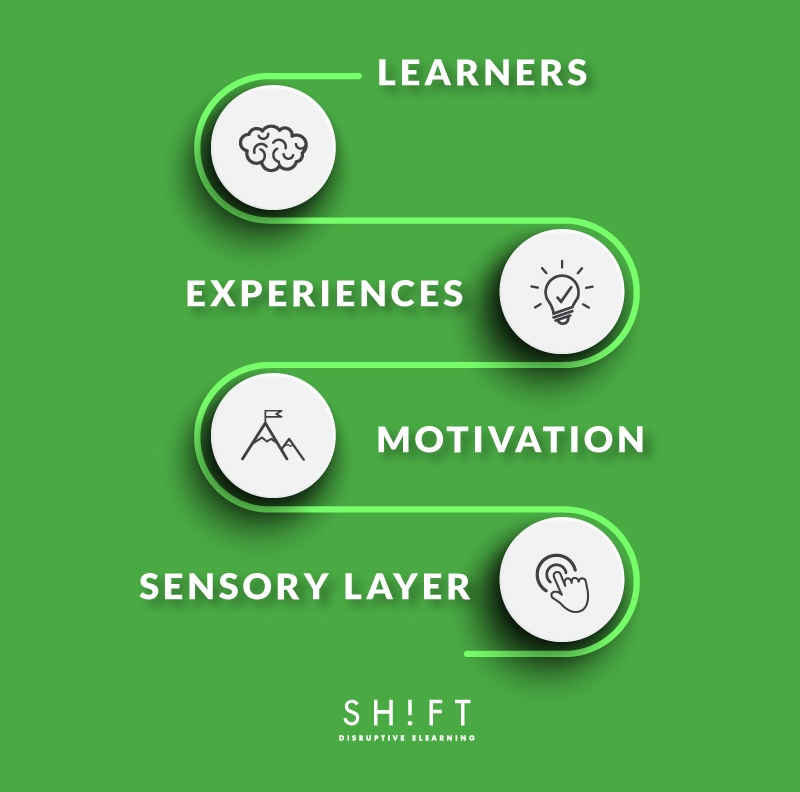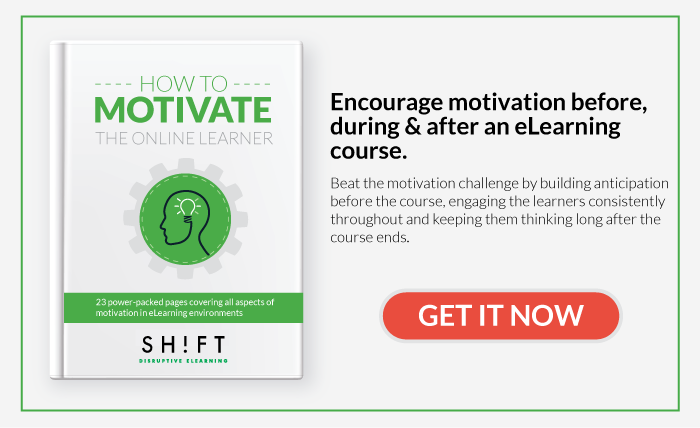There are four key elements or aspects of LXD (Learning Experience Design) that are critical for the success of your eLearning course. But before we get to those four things, let’s clarify some terminology:
- User Experience Design (UXD) is employed in the product development field. It is the process of improving the experience of the user by enhancing usability, accessibility, and pleasure during use of a product.
- Learning Experience Design (LXD) uses the principles of UXD to improve and support eLearning outcomes while enhancing the learner’s retention and application of the content. It’s about making technology work for the learner.
Read more: Learning Experience Design: An Overview and 11 of the Best Resources
Both UXD and LXD emphasize reducing friction, increasing enjoyment, and engaging the user in the experience. In the case of eLearning, the experience is the learner interacting with the course. This experience includes every aspect of the training program, from searchability to mobile-friendly formatting and beyond.
LXD is at the intersection of instructional design and user experience design. The aim is to promote GREAT and EFFECTIVE learner experiences, in addition to delivering customized content based on learner’s needs and background. That’s where the four elements of LXD come into play.

Element #1: Understanding Learners
Not all learners can be expected to reach the same goal in the same way. Each learner will be starting from a different place on the experience curve, from total novices to those with some foundational knowledge. They will have different preferences for learning environments and technologies too. Based on this, LX designers use tools to assess the learner’s competence and experience levels and allow them to skip over sections they already know or don’t need to cover.
LX designers consider the following:
- Desired outcomes of their learners
- What their learners already know about the topic
- Ways to find, create and use resources to implement the best learning experience
- The constraints of the adult education learning context
- Their learners’ past and present experiences
- Ways to motivate their learners to participate in the learning experience
- The future aspirations of their learners
Some go so far as to create learner personas, where they develop in-depth prototypes of their learners. This helps LX designers create more engaging content based on these profiles.
Another approach is to use design thinking techniques to prototype learning experiences. Design thinking has five principles:
1. Showing empathy for users, by considering their likes and dislikes, etc.
2. Properly framing the problem by asking the right questions
3. Using brainstorming or ideation for new ideas
4. Expanding new ideas into a prototype, storyboard, or mock-up
5. Testing, to figure out what must be done to ensure success
Read more: Important Lessons eLearning Professionals Can Learn From Design Thinking
Element #2: Experiential Learning
Too often corporate training fails as a result of only focusing on tasks, rather than experiences. A typical corporate learning program may be functional, reliable, useful, and convenient, but many times it's not pleasurable or even meaningful. That’s not to say that LX designers can ever forget the basics of functionality, usability, and convenience...but, they should not stop there when creating a course. Instructional Designers need to engage learners intellectually, emotionally, and physically while they guide them to discover solutions on their own.
Go back to David A. Kolb's Experiential Learning model – see how he emphasizes critical thinking, problem-solving, and learning by doing.
David A. Kolb reveals the cyclical nature of experiential learning by explaining how it takes place in four stages:
- Concrete Experience (CE): Encourage physical actions (simulations) and learning that evokes strong emotional responses (realistic scenarios that reveal cause-effect relationships) create powerful experiences that are not forgotten easily.
- Reflective Observation (RO): Learners need to engage with and reflect on their experiences to glean insights and acquire knowledge. So it is critical to not only create opportunities for experience-based learning but also provide time and space to encourage reflection.
- Abstract Conceptualization (AC): The success of experiential learning lies in the learner being able to decode abstract concepts from their reflections, generalize these ideas, and realize the relevance to their reality. Designs assessments to encourage learners to exercise their “critical thinking” abilities, so they can formulate concepts and procedures.
- Active Experimentation (AE): Role-playing activities, internships, and other hands-on tasks let learners apply the learning and thus truly “learn by doing.” Active experimentation leads to concrete experiences, and the cycle of experiential learning resumes.
Read more: 3 Adult Learning Theories Instructional Designers Must Know
Experiential learning is motivating because learners immediately realize that they are learning skills that they can employ in real life. They see the learning outcomes being fulfilled and feel encouraged to continue with the course.
Read more: Create Life-Long Learners with Experiential eLearning
Element #3: Engagement and Motivation
The core of learning experience design is on the human, not the content itself. Therefore, the course experience should be designed to engage and motivate the people taking your course to help them get the most out of it.
Here are some tips:
- Don’t rely on just extrinsic motivation (e.g., rewards, prizes, etc.). Instead, think of ways to intrinsically motivate learners (e.g., self-determination, autonomy, relatedness, etc.)
- Think of your training course as an active journey with an emphasis on learner engagement, rather than a single one-time passive event. Keep in mind all the different ways that your learner connects with your course, whether that’s emotional, behavioral, or cognitive. Make certain that they understand the flow of their learning journey, and how all of the parts fit together. Your goal is to design training that has a lasting impact and transfers back to the workplace.
- Give learners a challenge to apply and share their new knowledge within a specific period. You can even use social media for this step.
- Provide ways for learners to find their own intrinsic motivation by having them discover their own reasons why and how they are taking the training.
- Keep the user interface clean, simple, and understandable so it doesn’t get in the way of learning.
- For learners to be able to analyze, synthesize, and evaluate the learning content, you will need to engage them in a variety of activities. These might include role plays, reading, research, discussion, case studies, and so on.
Get your free eBook: How to Motivate the Online Learner
Element #4: Sensory Layer
LX designers consider the sensory experience of their learners. This includes all aspects of the program, from what it looks like to what it sounds like. All the materials and instructions designed for the program need to accommodate your learners’ senses.
Pay attention to the following:
- The tone of the written content and instructions
- The visual design of the materials
- The mood of the experience
- The aesthetic appeal of the overall program
The sensory aspects of the design implicitly communicate information about the learning experience. LX designers strive for courses that are beautiful as well as functional.
Gone are the days of just putting content on a web page and calling it “training.” Today’s learners expect much, much more. They want aesthetically pleasing course materials that engage them and motivate them, and make allowances for differing backgrounds, learning styles, and levels of pre-requisite knowledge. All of these are accomplished by following the principles of LXD.
CONSULTED SOURCES:
http://theelearningcoach.com/elearning_design/learning-experience-design-trends-2018/
https://elearningindustry.com/learning-experience-design-what-need-know
https://futures.uts.edu.au/blog/2017/10/18/nutshell-learner-experience-design-lx/
http://boxesandarrows.com/elements-of-learning-experience-design/


